Sixth video in the Tech TV series presents pros and cons of various control strategies. Lindon, UT — Preventing Legionnaires’ disease by controlling the growth of Legionella bacteria in water systems is the topic of the latest Tech TV video from Aquatherm. The video is available at https://aquatherm.com/videos/legionella. Legionnaires’ disease is transmitted through inhalation of Read more
legionella
Sixth video in the Tech TV series presents pros and cons of various control strategies.
Lindon, UT — Preventing Legionnaires’ disease by controlling the growth of Legionella bacteria in water systems is the topic of the latest Tech TV video from Aquatherm. The video is available at https://aquatherm.com/videos/legionella.
Legionnaires’ disease is transmitted through inhalation of water vapor in which the Legionella bacterium is present. It can present a very serious health risk to susceptible populations. Sources in a building can include misters, humidifiers, whirlpools and spas, evaporative coolers, and open- and closed-loop cooling towers. The best means of controlling Legionnaires’ Disease is by eradicating Legionella from a building’s water supply.
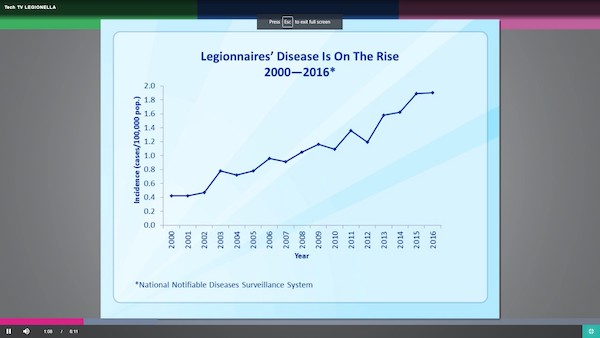
In this Tech TV video, Jim Paschal, P.E., Chief Technology Officer, Aquatherm North America, evaluates the pros and cons of various chemical and non-chemical Legionella control strategies, including hyper chlorination, chlorine dioxide, monochloramine, copper-silver ion generation, heat, and ultraviolet light.
The Legionella video is the sixth in the series of Aquatherm Tech TV videos. Other topics have been mixed systems, temperature, pressure, flow rate, and support considerations. All Tech TV videos can be found here: https://aquatherm.com/video-library. All of the videos in the series are free and available 24/7.

Watts has announced the next installment in a series of webinars for their engineer, architect, designer, and facility manager customers: Smarter, Safer Hot Water, to be broadcast live on Wednesday, August 28, 2019. This latest webinar will focus on how digital mixing valves enable engineers, designers, and facility managers to directly measure, monitor, and deliver Read more
Watts has announced the next installment in a series of webinars for their engineer, architect, designer, and facility manager customers: Smarter, Safer Hot Water, to be broadcast live on Wednesday, August 28, 2019.
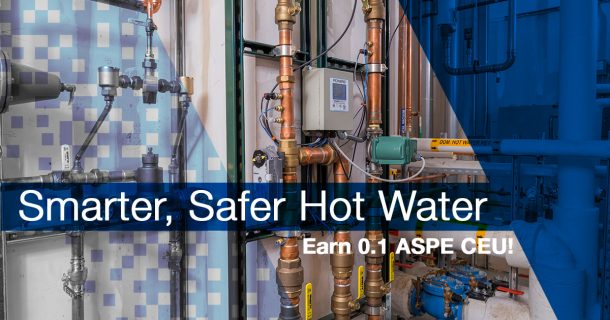 This latest webinar will focus on how digital mixing valves enable engineers, designers, and facility managers to directly measure, monitor, and deliver safer hot water through domestic water systems.
This latest webinar will focus on how digital mixing valves enable engineers, designers, and facility managers to directly measure, monitor, and deliver safer hot water through domestic water systems.
Key points to be covered include an overview of how digital mixing valves:
- Efficiently deliver mixed water throughout a hot water recirculation loop while allowing remote monitoring and control of water temperatures,
- Minimize the risk of waterborne bacteria in high-performance commercial and institutional facilities, and
- Provide precise control needed to deliver high water temperatures that mitigate the risk of the deadly Legionella bacteria (the cause of Legionnaires’ disease) while avoiding the risk of scalding and thermal shock injuries.
By attending the entire webinar, attendees can receive 0.1 Continuing Education Units (CEUs) through the American Society of Plumbing Engineers (ASPE).
To register for this webinar, please visit this page.
ASHRAE Resources Provide a Comprehensive Approach to Preventing the Growth and Spread of Legionella in Buildings, Campuses and Healthcare Facilities — ATLANTA — ASHRAE, a non-profit technical society headquartered in Atlanta, has developed resources to help reduce the risk of Legionella, including Standard 188, which provides a comprehensive approach to help prevent the growth and Read more
ASHRAE Resources Provide a Comprehensive Approach to Preventing the Growth and Spread of Legionella in Buildings, Campuses and Healthcare Facilities —
ATLANTA — ASHRAE, a non-profit technical society headquartered in Atlanta, has developed resources to help reduce the risk of Legionella, including Standard 188, which provides a comprehensive approach to help prevent the growth and spread of Legionella within building water systems.
“With the recent outbreak of Legionnaires’ disease in Atlanta, we would like to increase awareness of the resources available to help minimize health risks associated with building water systems,” said Darryl K. Boyce, P. Eng, 2019-20 ASHRAE President.
The CDC estimates approximately 6,100 cases of Legionnaires’ disease in the United States each year. Most of those cases result from exposure to Legionella found in building water systems.
ASHRAE has also reached out to the Fulton County Board of Health and the Georgia Department of Public Health to make these government offices aware of ASHRAE resources.
In 2018, ASHRAE published a revised edition of Standard 188, which designers and building operators can use to help establish water management plans specific to the systems in particular buildings, campuses or health care facilities. Guideline 12, Minimizing the Risk of Legionellosis Associated with Building Water Systems, is currently in revision and provides more detailed descriptions of best practices.
“By creating a framework for proactively managing building water systems and reducing the potential for Legionella growth in these systems, following Standard 188 can help building and facility managers prevent many but not all cases of legionellosis,” said Boyce.
The 2018 edition of Standard 188 provides:
- A description of environmental conditions that promote the growth of Legionella, such as water temperature fluctuations, water pressure changes and water stagnation.
- Minimum Legionellosis risk management requirements for buildings and associated potable and non-potable water systems.
- Requirements for Legionellosis control strategies and documentation.
- Clarification of compliance requirements, as well as an update to enforceable, code-intended language to facilitate adoption of the standard for code and regulatory purposes.

The oyster appetizer tray made its way around the table during our group dinner, and I asked the guy sitting next to me if he wanted first dibs, to which he replied, “No thanks, I know where they’ve been.” I mean, I kinda knew, but maybe not as much as this guy? So I declined Read more
The oyster appetizer tray made its way around the table during our group dinner, and I asked the guy sitting next to me if he wanted first dibs, to which he replied, “No thanks, I know where they’ve been.” I mean, I kinda knew, but maybe not as much as this guy? So I declined, as well.
Turns out, “that guy” sitting next to me was Frank Sidari, PE, BCEE, Technical Director, Special Pathogens Laboratory (SPL), and one of the featured speakers at a recent Watts Water Technologies Healthcare Symposium. Sidari was there to speak about Legionella and its growth, and the growing concern in the industry.
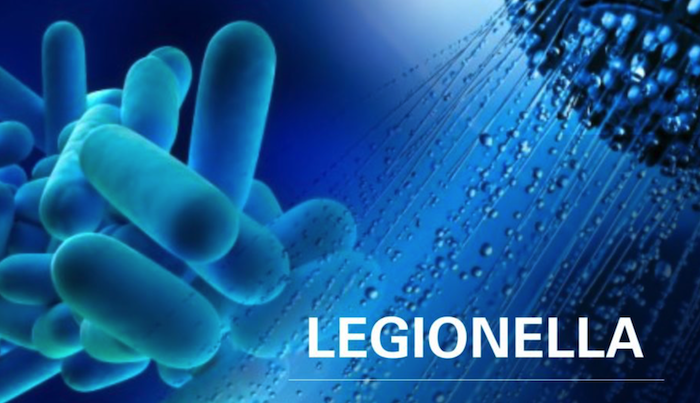
“No one should die from a preventable disease caused by bacteria in water,” said Sidari, suggesting that Legionnaires’ Disease is on the rise. Part of this rise correlates to the fact that there wasn’t really any testing being done for Legionella. Yet, it’s one of those “It’s never going to happen to me”-type diseases. What could have been mistaken for other ailments, the disease was often times diagnosed as pneumonia or the flu in older people, or those with auto-immune disorders.
According to the SPL presentation, public water supplies may contaminate the plumbing systems of hospitals and other large buildings. In fact, Legionella bacteria is not ubiquitous, but are found in 50% of building water systems—not all—which consist of:
- 12-70% of hospital water systems
- Up to 60% of large high-rise buildings
- 10-40% of residential homes
- 30-50% of cooling towers colonized with Legionella
Legionella can be found in building warm water systems such as faucets, showers, hot water tanks, decorative fountains, pools, spas and cooling towers, for example.
Transmission of pathogenic Legionella in the water system is the aerosolization and aspiration from an environmental source into the lungs—when the exposure to contaminated water reaches the airways—and because it is chlorine tolerant, it can survive the water treatment process and pass into the water distribution system. It grows in the water systems in the right conditions, i.e. water temperature, sediment and commensal microbes. Again, the disease can occur if the host is susceptible.

Frank Sidari
Variables such as water flow, distribution, velocity and temperature and play an important part for risk reduction. Risk factors such as water supply, building use and size, system design and hot water set-up all contribute to a safe and effective plumbing system.
The Center for Disease Control and Prevention has reported that Legionella accounted for 66% of reported drinking water-associated outbreaks, and Legionella in building plumbing systems lead to drinking water-associated outbreaks.
As there has been movement for the Center of Disease Control to develop a water management program to reduce Legionella growth in buildings, Illinois senators, for example, sent a letter to the leaders of three health-related agencies—the Centers for Disease Control and Prevention, the Department of Veterans Affairs, and the EPA—asking for their help in responding to a Legionnaires’ disease outbreak at a state-run veterans home, in Manteno, says Dain Hansen, Senior Vice President, Government Relations, The IAPMO Group.
This comes on the heels of a Legionnaires’ disease outbreak at an Illinois veterans’ home in Quincy that killed 14 people since 2015.Traction is being made in Illinois. “In response to the ongoing crisis, Illinois’ new governor, J.B. Pritzker, has established a Legionnaires’ disease task force, and the senators also requested that the three federal agencies participate in that effort,” says Hansen.
In New York state, environmental assessments are required with a Legionella sampling and risk management plan is in place where <30% distal outlet positivity requires corrective action.
Industry-wide, ASHRAE Standard 188, the first Legionella standard in the U.S., which was approved in 2015 and revised in 2018, establishes minimum Legionellosis risk management requirements for building water systems.
According to the Special Pathogens Laboratory, zero Legionella is virtually impossible to achieve in complex water systems so zero cases is the goal, not zero Legionella through Legionella control. The SPL suggests that in hospitals and long-term care facilities—and other facilities I would presume—establishing water management policies to reduce the risk of growth and spread of Legionella and other opportunistic pathogens, conducting a risk assessment and implementing a water management program are all very good ideas for a facility.
Each building owner must assess the risk and validate their water management plans to demonstrate control of the hazard. The SPL suggests that in hospitals and long-term care facilities—and other facilities, I would presume—establishing water management policies to reduce the risk of growth and spread of Legionella and other opportunistic pathogens, conducting a risk assessment and implementing a water management program are all very reasonable considerations for a facility.
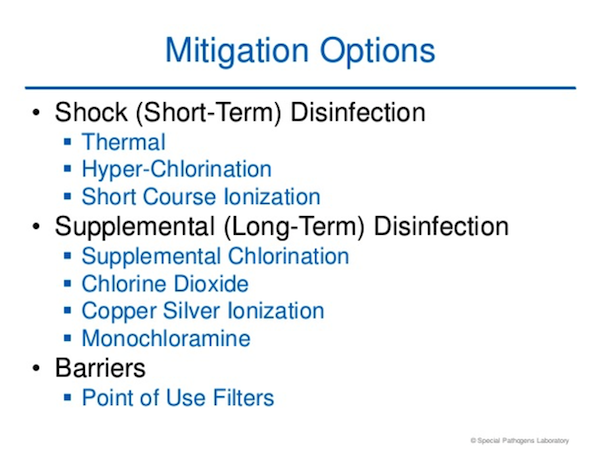
Source: Special Pathogens Lab

ThermOmegaTech®, a world leader in the design and manufacture of self-actuating thermostatic valve technology, introduces the CircuitSolver® Sanitary Flush (CSUSF) Valve as the newest addition to their CircuitSolver® line. The CSUSF allows for higher-temperature water to flow through a domestic hot water system during the disinfection process to protect against Legionella growth in systems capable Read more
![]() ThermOmegaTech®, a world leader in the design and manufacture of self-actuating thermostatic valve technology, introduces the CircuitSolver® Sanitary Flush (CSUSF) Valve as the newest addition to their CircuitSolver® line. The CSUSF allows for higher-temperature water to flow through a domestic hot water system during the disinfection process to protect against Legionella growth in systems capable of high-temperature flushes.
ThermOmegaTech®, a world leader in the design and manufacture of self-actuating thermostatic valve technology, introduces the CircuitSolver® Sanitary Flush (CSUSF) Valve as the newest addition to their CircuitSolver® line. The CSUSF allows for higher-temperature water to flow through a domestic hot water system during the disinfection process to protect against Legionella growth in systems capable of high-temperature flushes.
Nick Tallos, Vice President of Engineering for ThermOmegaTech® says, “CircuitSolver® technology was already an innovative balancing method for domestic hot water systems. Now, with the addition of the Sanitary Flush, CircuitSolver® further stands out as a revolutionary technology with a myriad of applications. With its capability to protect against Legionella growth, the CircuitSolver® becomes an even easier and reliable balancing solution. It’s just another step in the right direction.”
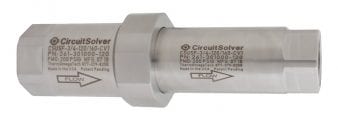 The CircuitSolver® is a thermostatic, self-actuating balancing valve that continuously and automatically adjusts the flow through each branch of a domestic hot water recirculation system to maintain the specified temperature at the end of each branch, regardless of fluctuations in hot water demand. It is a direct replacement for manual balancing valves and eliminates balancing labor and callbacks. The CSUSF valve uses two high-thrust actuators, a low-temperature actuator to maintain standard balancing temperature, and a high-temperature actuator to allow for high temperature sanitary flushing of the system.
The CircuitSolver® is a thermostatic, self-actuating balancing valve that continuously and automatically adjusts the flow through each branch of a domestic hot water recirculation system to maintain the specified temperature at the end of each branch, regardless of fluctuations in hot water demand. It is a direct replacement for manual balancing valves and eliminates balancing labor and callbacks. The CSUSF valve uses two high-thrust actuators, a low-temperature actuator to maintain standard balancing temperature, and a high-temperature actuator to allow for high temperature sanitary flushing of the system.
The CircuitSolver® Sanitary Flush Valve is tamper-proof and automatically balances any domestic hot water system at a set temperature, while still allowing higher water temperatures to enter for disinfection, preventing Legionella growth. It is the ideal solution for a maintenance-free balancing and high-temperature flush application. The CSUSF is lead-free, stainless steel, and corrosion resistant. The CSUSF valve is NSF/ANSI 61certified, comes equipped with a long service life and 3-year warranty.
ThermOmegaTech®’s CircuitSolver® Sanitary Flush Valve is available for purchase through your local representative. For more information visit www.CircuitSolver.com or call 877-379-8258.
